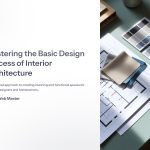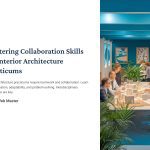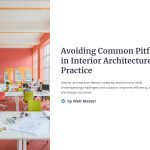 Interior architecture practice involves a blend of creativity, technical knowledge, and practical application. However, students and professionals alike face various challenges during hands-on training. Understanding these issues and their solutions can help improve efficiency, safety, and design outcomes.
Interior architecture practice involves a blend of creativity, technical knowledge, and practical application. However, students and professionals alike face various challenges during hands-on training. Understanding these issues and their solutions can help improve efficiency, safety, and design outcomes.

Lack of Practical Experience and Skills
Many students struggle with translating theoretical knowledge into practical application, leading to poor execution in real-world projects.
Solution
- Engage in hands-on projects early by working on small-scale models or real renovation projects.
- Participate in internships or workshops to gain industry exposure.
- Use simulation software to practice design and execution before actual implementation.

Poor Space Planning and Design Errors
Inefficient space utilization or design errors can lead to impractical layouts that don’t meet client needs.
Solution
- Conduct thorough research and site analysis before starting a design.
- Use software tools like AutoCAD, SketchUp, or Revit to test layouts before implementation.
- Gather feedback from peers and mentors to refine design ideas.

Material Selection Issues
Choosing the wrong materials can lead to durability problems, aesthetic inconsistencies, or cost overruns.
Solution
- Understand the properties of different materials through experimentation and industry case studies.
- Work with suppliers to get material samples before finalizing choices.
- Consider sustainable and cost-effective alternatives without compromising quality.

Time Management Challenges
Students and professionals often struggle to complete projects within deadlines due to poor planning or unforeseen challenges.
Solution
- Create a detailed timeline and break the project into manageable phases.
- Prioritize tasks and use project management tools like Trello or Asana.
- Allow buffer time for unexpected delays and revisions.

Safety and Compliance Issues
Ignoring safety regulations can lead to hazards during construction and installation.
Solution
- Stay updated with local building codes and safety regulations.
- Wear appropriate protective gear and ensure a safe working environment.
- Conduct safety training sessions regularly.

Budget Constraints and Cost Overruns
Budget limitations can affect material quality and project feasibility.
Solution
- Develop a detailed budget plan at the beginning of the project.
- Compare multiple suppliers to get cost-effective materials.
- Monitor expenses and adjust plans if necessary to stay within budget.
Conclusion
Interior architecture practice requires a balance between creativity and technical proficiency. By identifying common challenges and implementing proactive solutions, students and professionals can enhance their skills and produce high-quality designs.
*Capturing unauthorize d images is prohibited*
d images is prohibited*



